Adinkra Symbols & Meaning
LOVE - AKOMA - Heart
In celebration of the beauty and diversity of the cultures from which we all originate,
Akoma is the Adinkra symbol for love, patience, and joy. The circular design of the medallion represents unity. The word, Akoma, means “oneness” in the Twi language, signifying that we are all one people, regardless of race or religion.
UNITY - FUNTENMFUNAFU DUA - Siamese Crocodiles
A symbol of oneness, unity, and friendship among different people, religions, and cultural tolerance.
This is a symbol of unity in a diverse environment. These reptiles share one stomach, yet they fight over food. There is urgency in implementing this ideology: the union of people from different cultural backgrounds must achieve commonly shared objectives despite their divergent views and opinions about the way of life. The symbol stresses the importance of democracy in all aspects of life. It also encourages inclusiveness and naturally discourages discrimination.
STRENGTH - OSIADAN NYAME - God The Builder
"We build our castles, and we build our belief systems upon the rock of God the Builder." The Adinkra symbol for "God the Builder" stands as a reminder that we can create security and stability for ourselves out of our beliefs.
A remind you that togetherness makes anything possible. It is a symbol of courage, hope & love, which are the three pillars on which all great relationships are built.
NEW BEGINNING - OWIA A REPUE - Rising Sun
The rising sun represents a new day and brings with it warmth hope and strength. It is a symbol that radiates energy, optimism, and progress.
Comforting for those who are searching for solace, spiritual enlightenment or self-improvement.
SECURITY & PROTECTION ADOBE SANTANN - All seeing eye
The Adobe Santann symbol was used by the Ashanti people to depict Eshu, a powerful protector of spirit. Eshu was often invoked as a way to keep evil at bay and for protection from those who would do harm. In North America, you'll find this symbol interpreted as the All-Seeing Eye of God, a reminder that he sees all our actions and grants us strength and wisdom to carry out His will.
ENDURANCE - AYA - Fern
The AYA is one of the most popular symbols in the Adinkra family, worn to symbolize endurance, resourcefulness, and defiance. It's part of the tree of life family and also represents new beginnings. The fern is a plant that can grow in difficult places; it is resilient and resourceful.
LET THE PAST GUIDE YOU SANKOFA - Bird
The Akan believe that the past is a guide to the future. For generations, the Sankofa bird has represented the connection between the past and the future. The skill to use knowledge of our history to inform our present actions is a tool for building a strong future for all.
UNITY - MMOMUDWAN -
A symbol of the power of unity and the ability to withstand challenges, strength is a virtue. This adinkra symbol is worn to remind you and others that there's strength in numbers and that you should never give up. Wear it to remind yourself that you're not alone — we're all in this together.
BEAUTY- DUAFE - Comb
The duafe was a prized possession of the Akan women of Ghana, used to comb and plait their hair, and symbolizes femininity and beauty. It is also the symbol of goodness, love, and care and recognizes the special energy women possess.
ENLIGHTENMENT - OSRAM NE NSOROMMA - Crescent Moon & Star
An Adinkra symbol of enlightenment, the crescent moon, and the star represent the radiance of wisdom. This symbol signifies love, devotion, bonding harmony affection, and faithfulness.
ASASE YE DUR
The Land is Mighty
This is a symbol of power and strength. A symbol that reminds you that no matter what the situation, if you believe in yourself
This symbol helps you to remember that nothing is impossible and that anything can be accomplished if you try.
EYE OF HORUS - Left Eye representing protection, health, and restoration. According to Egyptian myth, Horus lost his left eye in a struggle with Seth. The eye was magically restored by Hathor, and this restoration came to symbolize the process of making whole and healing.
EYE OF RA - Right Eye Ra is the sun god, it's power is quite close to the almighty gods of the monotheistic religions. In this sense, his power of vision is thus unlimited, his eye is called “the eye that sees everything”.

ANHK - Cross representative of eternal life in Ancient Egypt which was created by Africans long ago the ankh is said to be the first or original--cross. The ankh is often shown in the hands of important Egyptian figures, such as pharaohs and kings, preserving their immortality. Moreover, the ankh is commonly depicted in temples and in the grasp of major Egyptian gods such as Osiris, Isis, and Ra. It could also have a more physical connotation: the ankh may represent water, air, and the sun, which were meant to provide and preserve life in ancient Egyptian culture.








